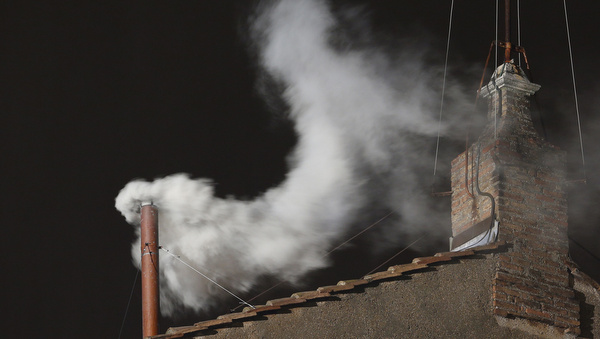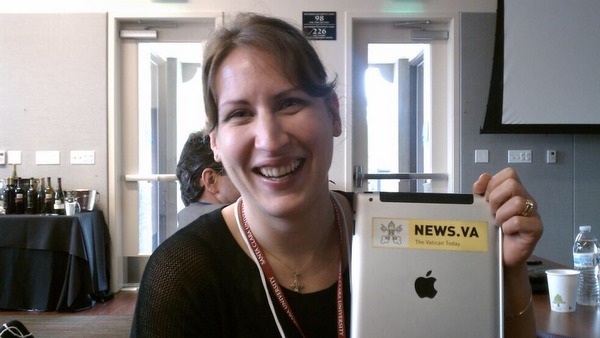

The Church in the Digital Age
Cheridan Sanders
Saturday, May 16, 2015

For an institution that still uses smoke signals to communicate the election of a new leader one wonders how the Church will respond to the challenges of the digital age? When I reflect on this topic, I can’t help but remember when the good old Pope Benedict launched News.va. That’s right, in case you’ve forgotten, it was Pope Benedict's finger that launched NEWS.VA.
Isn’t there something incredible about an image of a Council Father, like Pope Benedict, launching a news portal via an ipad. Two worlds literally meeting at the tip of a finger. Reminds me of the scene of Adam and God in the Sistine chapel.
In light of the World Communications Day, I caught up with Professor Daniella Zsupan-Jerome, Author of Connected Toward Communion: The Church and Social Communication in the Digital Age to share some insights with us:
 Professor Daniella Zsupan-Jerome with iPad that Pope Benedict used to launch @Pontifex
Professor Daniella Zsupan-Jerome with iPad that Pope Benedict used to launch @Pontifex
 The Producer Diaries
Cheridan Sanders, a Producer at Salt and Light Television, reflects on her experiences as she travels the world telling Catholic’s stories.
The Producer Diaries
Cheridan Sanders, a Producer at Salt and Light Television, reflects on her experiences as she travels the world telling Catholic’s stories.
 Professor Daniella Zsupan-Jerome with iPad that Pope Benedict used to launch @Pontifex
Professor Daniella Zsupan-Jerome with iPad that Pope Benedict used to launch @Pontifex
Today we celebrate the 49th World Day for Social Communications. Any thoughts on the Pope’s Message? I recommend praying with this beautiful document. It invites us into the family of Jesus to re-learn some of the beauty and richness of human communication. The meditation on the Annunciation and the Visitation are especially profound as Pope Francis leads us to recognize how communication itself was made sacred in the Word becoming flesh through the yes of Mary. True to form, Pope Francis guides us from meditation to recognition in our own lives: to the reality of our own families and how communication emerges and grows from this basic human experience. I love his reflection on the womb as “the first school of communication” where the encounter between mother and child, “so intimately related while still distinct from each other, an encounter so full of promise, is our first experience of communication.” I also appreciate the challenge he names regarding digital culture: “The great challenge facing us today is to learn once again how to talk to one another, not simply how to generate and consume information.” He is calling us back to encounter here, back to recognizing the person in front of us, back to the basic posture of relationship that we are made for in the image and likeness of God. He challenges us here I think to think creatively and faithfully about how to do this in and through digital communication. The Church in many places seems to still prefer analogue communication like radio (or smoke signals), are we ready for the digital age? One of the reasons I love the Roman Catholic Church is because of its long-history of being “multimedia” as well as its beautiful theology of communication. Our theology set us up to think in terms of mediation, sacramentality, and grace present in and through something that conveys or carries it. We think of God’s relationship with us as God’s self-communication. We consider Christ as the Word Incarnate. We live empowered by the Spirit who has given us the ability to speak. All of these are a solid foundation for thinking about communication today. The Catholic tradition is a multimedia tradition: we honor the body as our primary medium, we embrace the stuff of the earth as our sacramental symbols, we have a long history of art, performance, music, manuscript, print and even electronic media to illuminate, educate and inspire. All this makes us not only ready for digital culture, but sets us in a position of thought-leadership in terms of how to do this well. Ok, what are some of the practical implications for priestly and lay formation? If we are living in a digital culture, then it is important to begin to think in cultural terms, rather than simply about specific tools, skills or platforms to use in ministry. For ministerial formation, this means thinking more broadly. For priestly formation, it raises questions about how to teach, govern and sanctify digital culture, or more specifically, the people we are called to serve in our digital culture. For the lay minister, it is about how to live a baptismal call to share the Gospel, to be a communicator of Good News in the digital age, whether at home, at work, in our social and professional contexts. For both lay and priestly formation, this brings an intentionality to communication, and engenders communication that is, at its core, an act of giving oneself in love. Even when it comes to a text or tweet, this is possible. Pope Francis seems to be a pretty savvy communicator, judging from his twitter followers and famous selfies, anything we can learn from him? Openness to learning and trying something new, courage to look “human” while doing it, and the commitment to seek encounter with people through the screen, especially those who need healing and reconciliation the most. In your book you made an interesting observation about the location of the Media on the Council Father’s agenda. Mind letting us in on that 'Conciliar joke'? At the first session of the Second Vatican Council, the Council Fathers placed the discussion on Inter Mirifica (Decree on Mass Media) intentionally following the discussions on the liturgy and revelation, and preceding forthcoming discussions on Christian unity, the Blessed Virgin Mary, and the church. Wedged between these heavier topics, the discussion on the topic of social communication was anticipated to be lighter, even called an “opportunity for relaxation” by Cardinal Cento, the president of the commission that oversaw the preparation of the schema on this topic. I am not sure how relaxing the discussion was, even if it dealt with the media. Over two and a half days, fifty-four Council Fathers gave a verbal address and an additional forty-three submitted written feedback. This sounds like work.Stay tuned for an upcoming episode of Catholic Focus featuring an interview with Professor Daniella Zsupan-Jerome!
 The Producer Diaries
Cheridan Sanders, a Producer at Salt and Light Television, reflects on her experiences as she travels the world telling Catholic’s stories.
The Producer Diaries
Cheridan Sanders, a Producer at Salt and Light Television, reflects on her experiences as she travels the world telling Catholic’s stories.
Related Articles:
Category: Highlight, synod, Synod2018, Synod2019, 主教會議2019
Tag: Synod of Bishops, 女性顧問團, 主教會議
教宗方濟各在聖瑪爾大之家的臨床狀況持續改善【2025年4月4日】
Saturday, April 5, 2025
 鹽與光
鹽與光
羅馬時間,2025年4月4日(星期五),聖座新聞室發表了有關教宗方濟各健康狀況的最新消息,教宗方濟各的臨床狀況持續改善。週日的三鐘經祈禱活動可能會以不同於以往主日的方式進行,並將於週六發布最新消息。
聖若望保祿二世逝世二十週年彌撒:求聖教宗降福受傷的世人
Friday, April 4, 2025
 鹽與光
鹽與光
聖座國務卿帕羅林樞機為聖若望保祿二世教宗逝世廿週年主持彌撒,紀念他為教會和世界帶來的深層改變。
教宗要理講授:即使感到無力改變,也不要失去希望
Thursday, April 3, 2025
 鹽與光
鹽與光
教宗方濟各在聖瑪爾大之家養病之際,發表了為4月2日週三公開接見活動準備的要理講授稿件。談到稅吏匝凱,教宗敦促信眾即使感到無力改變,也絕對不要失去希望。
香港教區全人發展委員會:歡迎下載《城市中的苦路默想》
Thursday, April 3, 2025
 香港教區全人發展委員會
香港教區全人發展委員會
教宗在2025的禧年詔書中,為世界呼求希望的恩寵,也邀請世人一同陪伴那些經歷各種困難的弟兄姊妹及弱勢社群。為響應禧年「希望的朝聖者」主題,香港教區全人發展委員會編製了《城市中的苦路默想》。歡迎下載及網上收看。
國際明愛全力援助緬甸大地震災民
Wednesday, April 2, 2025
 鹽與光
鹽與光
國際明愛為援助緬甸大地震災民發出呼籲,該機構的人道主義總監表示正與全球同盟一起動員資源,提供緊急人道救援,並協助重建被這場悲劇摧毀的生活。請大家慷慨捐助!
1
2
3
4
5
6
7
8
9
10
11
...
1363
>>
SUPPORT LABEL
$50
$100
$150
$250
OTHER AMOUNT
DONATE
Receive our newsletters
Stay Connected
Receive our newsletters

Stay Connected









